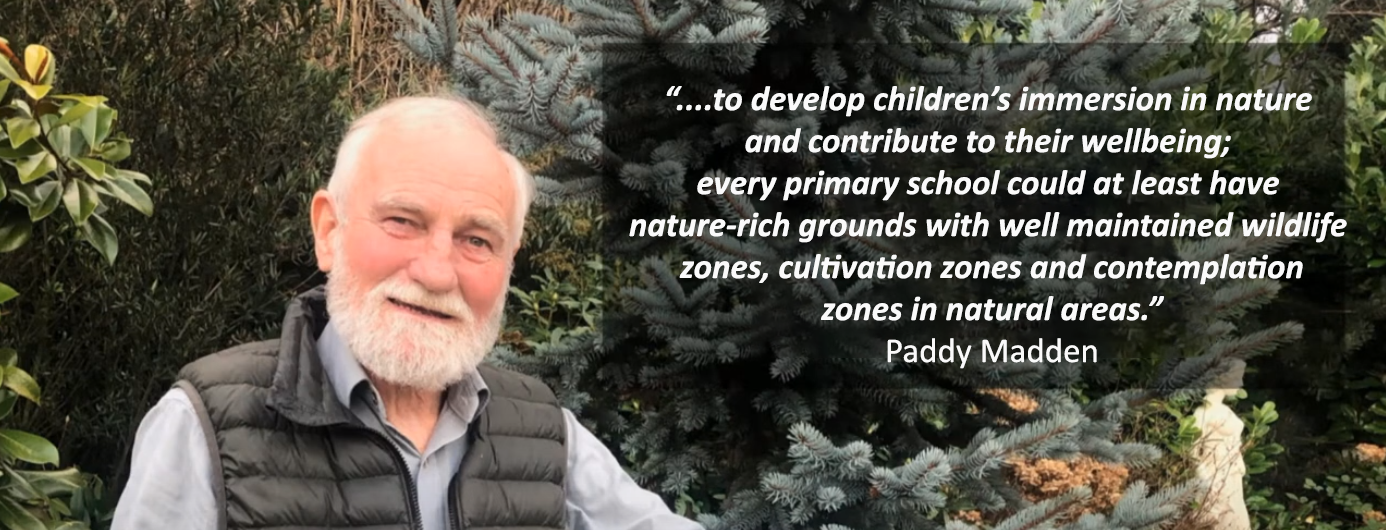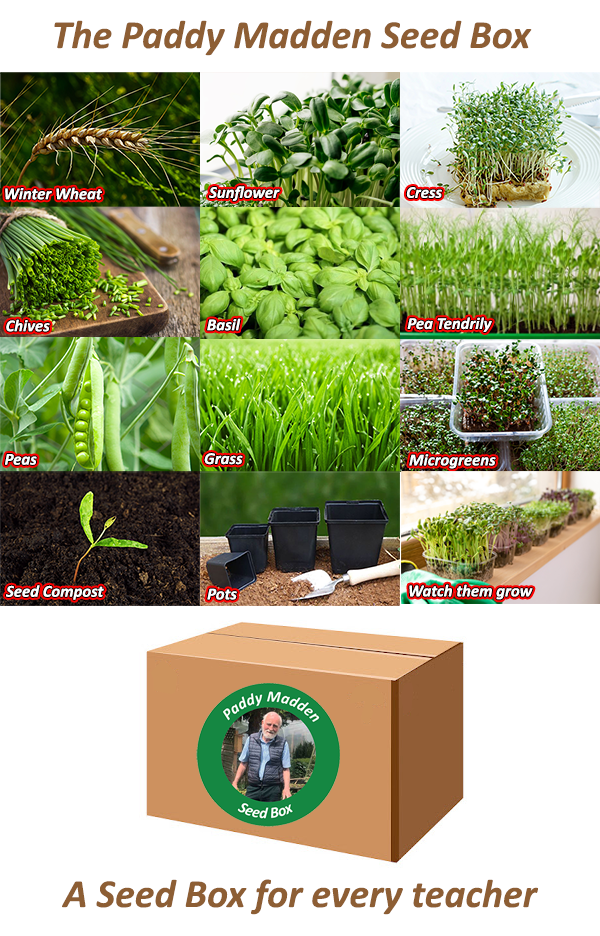
SG -School Gardening for STEM
What a powerful combination for learning.
Grow, garden and learn this summer in the company of Paddy Madden, your only man when it comes to school gardening!
We will send you ‘The Paddy Madden Seed Box,’ which contains a variety of seeds for you to experiment with, sow, and enjoy as part of the course. Nice one!

Please note that this resource pack cannot be dispatched outside Ireland.
This is the course that is jam packed with fantastic lesson ideas, STEAM projects, informative new videos from Paddy, resources galore to download, seeds for you to plant and just so much more.
We showcase how the school garden, great outdoors and immersion into nature is the perfect canvass on which to do teaching, learning and assessment, in a way that appeals to and energises children in learning.
Paddy is passionate about engaging children with nature and the outdoor learning environment that comprises the school garden, school grounds and the local hedgerows, lanes and byways of Ireland.
He contends that children should be able to identify their native trees, plants and insects, in the same way as they can name big brands and celebrities!
In each module Paddy showcases what is typically happening outside in nature month-by-month from September to June. From the first week of September, we highlight the opportunities for cross curricular lessons and immersive, engaging, hands-on learning by the children.
This is the pedagogy of ‘Garden Based Learning’ (GBL) at its very best.
Paddy informs us in his own inimitable way about plants and wonderous worms, seed germination, seed dispersal, trees, invertebrates, birds, amphibians, life cycles, rocks, soils & compost, sowing veg & potatoes, container gardening, vertical farming, bees, flowers, pollination, the hedgerow, butterflies and so much more.
Then comes the big STEAM Projects, each project fully scoped out, incorporating a multidisciplinary approach to each and every topic to include the elements of Science, Technology, Engineering, Art (both visual arts and languages) and Mathematics.
Each STEAM Project could be two weeks work, and each includes all the subjects as above.
- Plan & Build a Biodiverse Garden
- Build a Directional Compass Indicator
- Build an Invertebrates Hotel
- Build a Biome
- Build a Weather Station
- Build a Bird Box
- Design, Plan and Engineer a Bio-Diverse Garden
- Investigate and Record the Conditions Necessary for Germination
- Plant a Living Roof
- Build and Install a Sun Dial
- Build a Composter
- Build Hedgehog House.
- Build a Bird Feeder
- Build a Rock Habitat
- Plant an Indoor Garden
- Investigate Conditions for Growing
- Build Raised Beds
- Build a Vertical Farm
- Build a Model of a Pollinator
- Build a Nest
- Build a Rainwater Harvesting & Storage Mechanism
- Build Sensory Features into your Garden,
- Construct a 3D Model of Life Cycle of a Butterfly
- Model to Explain Bee Pollination
- Create a fun Tree Trail etc.
If you are looking for an engaging context in which to teach an integrated curriculum, then the ‘School Garden + Garden Based Learning’ (GBL) is the perfect approach.
Come, plant yourself into our garden this summer, and we will certainly grow you into a different kind of teacher, where you will let nature lead the way!
NOTE:
The on-line format of this course enables you to study at a time and place that best suits your own needs.
You can access your course anytime until March 31st 2026.
Within this highly interactive web-based course, a dynamic learning experience awaits. You can interact with your fellow course participants through the in-course chat forums and communication tools provided by the CPD College learning system.
Our friendly and knowledgeable tutors actively support each course, providing expert interaction, guidance and feedback for all participants on chat questions and assignments which call for critical reflection, self-analysis and a reasoned response.
On successful completion of your course, you can download and print off your CPD record and certificate of completion.
We look forward to welcoming you to your course.
- Raise teachers’ knowledge of nature in their school garden/local environment
- Skill teachers to implement the motivating Garden-Based Learning approach
- Enable participants to teach relevant content relating to their school garden/local environment each month
- Deliver a complete working understanding of what constitutes STEM/STEAM
- Showcase exemplars and skill teachers to develop STEAM projects
- Support teachers to vision and create integrated cross-curricular STEAM driven garden centric lessons each month
| 01 - September/October: Dr Paddy Madden outlines the biodiversity of the school garden, details what is happening in the school garden/grounds in Sept/Oct and itemises what to look for and what to do with students in their own school garden/local outdoor environment. In this module, the focus is on seeds, germination, seed dispersal, trees and invertebrates. Paddy provides intricate details to strengthen teacher knowledge and expertise in each area, before itemising and detailing the learning activities that they can springboard into lessons, with sample lessons provided throughout.
The pedagogy driving garden-based learning is detailed, and an experiential and project-based - inquiry/research approach is championed. The elements of STEAM are explored and detailed, with a suite of STEAM projects set out to include: Design, plan and engineer a Bio-Diverse Garden / Research, investigate, document and record the conditions necessary for germination/ Plant a living roof/ Build and install a sun dial/ Build a composter/ Research & construct a hedgehog gouse. |
|
02 - November/December: In this module, Paddy details the range of what is typically happening in the school garden in Nov/Dec and itemises what to look for and what to do with students in their own school garden/local outdoors environment. His focus now is on plants, wonderous worms, animal diversity and weather. Sample lesson plans are provided across the themes, itemising the learning outcomes and suggesting learner experiences. A suite of STEAM PROJECTS is also scoped out, with each project pulling in cross-curricular learning outcomes: pupils in groups are tasked to Research, design, and build a directional compass indicator/ Design and build an invertebrate hotel/Design and build a biome/ Design and build a weather station/ Design and build a bird box. |
| 03 - January/February: In the company of Paddy, we explore what is typically happening in the school garden in January/February and itemise what to look for and what to do with students in their own school garden/local outdoor environment. His focus now is on birds, amphibians, life cycles, rocks, and indoor gardening opportunities. Sample lesson plans are provided across the themes, itemising the learning outcomes and suggesting learner experiences.
A suite of STEAM PROJECTS is also scoped out, with each project incorporating cross-curricular learning outcomes: pupils in groups are tasked with researching, designing, and building a garden pond, a bird feeder, a rock habitat, an indoor garden, or Investigating growing conditions. |
|
04 - March/April: Paddy delves into what is typically happening in the school garden in March/April. He itemises what to look for and what to do with students in their own school garden/local outdoor environment. His focus now is on soil and compost, sowing vegetables and potatoes, container gardens, vertical farming and bees. Sample lesson plans are provided across the themes, itemising the learning outcomes and suggesting learner experiences. A suite of STEAM PROJECTS is also scoped out, with each project incorporating cross-curricular learning outcomes: pupils in groups are tasked with researching, designing, and building a vegetable bed, a vertical farm, a model of a pollinator, a nest, or a container to grow the tallest sunflower. |
| 05 - May/June: As we approach this time of year, Paddy details what is typically happening in the school garden in May and June. He itemises what to look for and what to do with students in their own school garden or local outdoor environment. His focus now is on flowers and pollination, the hedgerow, and butterflies. Sample lesson plans are provided across the themes, itemising the learning outcomes and suggesting learner experiences.
A suite of STEAM PROJECTS is also scoped out, with each project pulling in cross-curricular learning outcomes: pupils in groups are tasked to research, design and build: a rainwater harvesting and storage mechanism/ Build sensory features into the Garden/ Model the life cycle of a butterfly/ Design a model to explain bee pollination / Design and build a bird bath / Design and build a fun tree trail. |
" Absolutely fabulous course. Would highly recommend everyone to do this. It really makes you think that children need these skills to connect them with nature. I really enjoyed the videos from Paddy, and it was great to have seeds posted out so I could get hands-on with the learning." Rebecca, 2024
